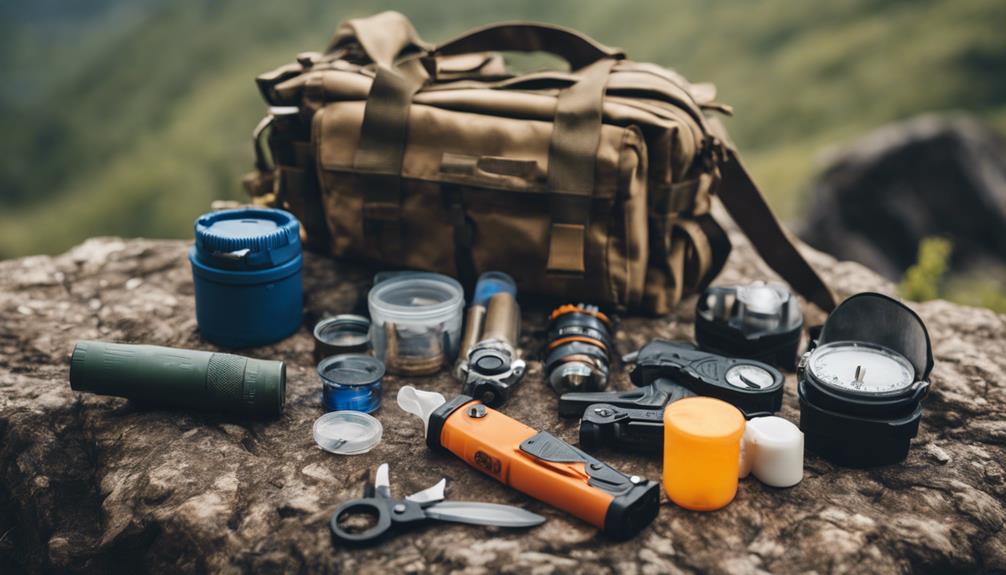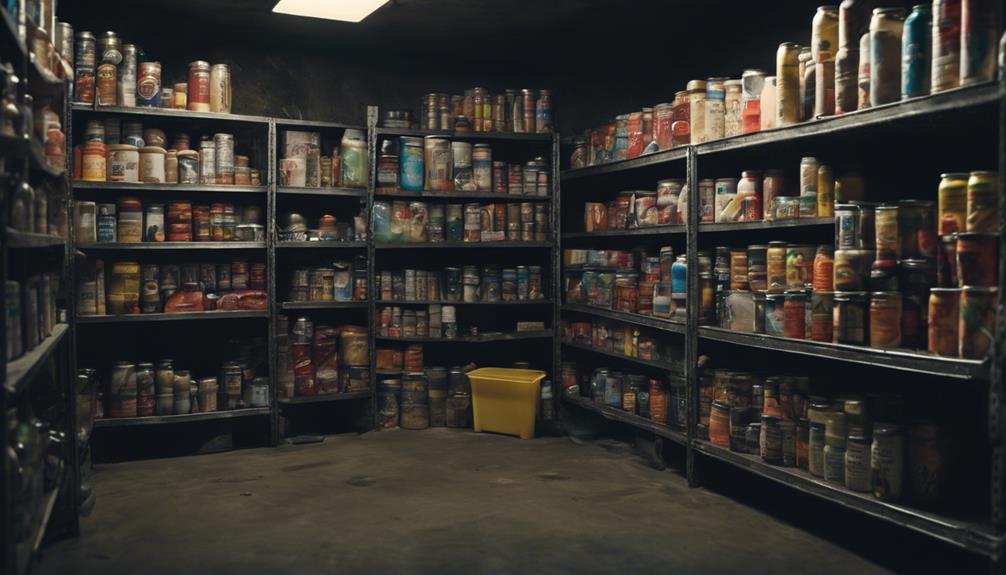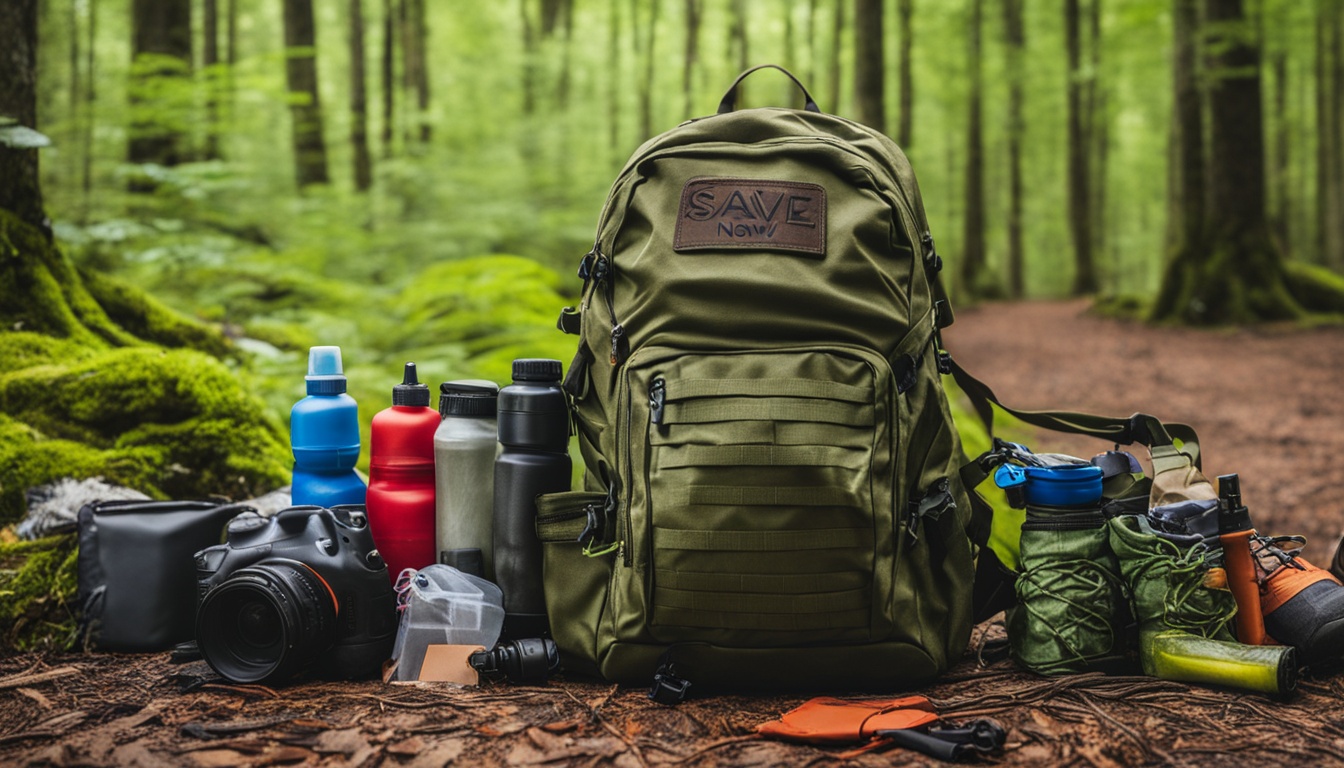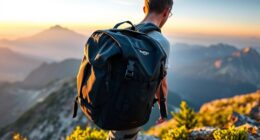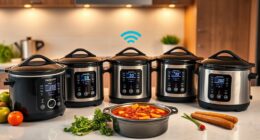For every survivalist, a preppers list should include essential gear for emergencies. Make sure legal documents like IDs are safe in watertight bags. Reliable light sources such as flashlights, lanterns, and glow sticks are essential. Stock up on first aid supplies and fire starting tools. Emergency communication devices like hand-crank radios are important for updates. Shelter essentials like tents and sleeping bags offer protection. Water purification tablets and personal protection gear are necessary. Miscellaneous items like duct tape and bug spray round out your kit. Having these items prepares you for unforeseen situations.
Key Takeaways
- Include legal documents like birth certificates for identification.
- Reliable light sources such as flashlights, lanterns, and glow sticks are essential.
- First aid kit with wound cleaning supplies, bandages, and pain relievers.
- Fire starting tools like waterproof matches and lighters are crucial.
- Emergency communication devices like hand-crank radios provide vital updates.
Legal Documents and IDs

Make sure to include legal documents and IDs in your prepper kit for quick access during emergencies. Essential items such as marriage certificates, birth certificates, and wills should be securely stored. Photocopies of important IDs like passports, social insurance cards, and driver's licenses are also important.
Place these documents in a flat, watertight bag to protect them from any potential moisture or damage. Having these legal documents readily available can be crucial during emergencies or evacuations. Quick access to IDs and essential legal paperwork can help expedite processes such as insurance claims or accessing emergency services.
In uncertain situations, having these documents at hand can save you valuable time and hassle. Make sure that your prepper kit includes these important legal documents and IDs to be well-prepared for any unexpected events.
Reliable Light Sources

When preparing for emergencies, it's essential to have reliable light sources on hand. Flashlights and lanterns provide bright illumination, while headlamps offer hands-free lighting convenience.
Glow sticks can also be useful for increasing visibility in the dark.
Flashlights and Lanterns
For essential light sources during emergencies, consider including flashlights and lanterns in your prepping supplies. Flashlights are vital tools that provide illumination in dark or dimly lit environments. They come in various sizes and designs, with options such as solar-powered or hand crank flashlights that eliminate the need for batteries.
Lanterns, like LuminAID's Power Lanterns, offer long-lasting brightness for up to 100 hours, making them ideal for extended emergency situations. Additionally, some solar-powered lanterns can serve as phone chargers, providing a multi-functional advantage in critical times.
In emergencies, having waterproof matches on hand is important for starting fires to provide warmth and cook food. These matches are designed to withstand damp conditions, ensuring they remain reliable when needed most.
When preparing your emergency kit, make sure to include a mix of flashlights, lanterns, and waterproof matches to cover your lighting needs during unforeseen circumstances.
Headlamps for Hands-Free
Consider adding headlamps to your prepping supplies for a reliable hands-free light source during emergencies. Headlamps offer convenient illumination while allowing you to keep your hands free for tasks like cooking, fixing shelter, or moving through the dark.
Ideal for outdoor activities, these lightweight devices are comfortable for extended wear. Most headlamps come with adjustable brightness settings and beam angles, allowing you to customize the lighting based on your needs. Look for models with rechargeable batteries or solar charging capabilities for sustainable power sources.
LED headlamps are particularly recommended for their long battery life, durability, and bright light output, which are essential for survival situations. Whether you're preparing for a power outage, camping trip, or a natural disaster, having a reliable headlamp in your emergency kit can make all the difference in ensuring you have adequate visibility and hands-free lighting when you need it most.
Glow Sticks for Visibility
Including glow sticks in your emergency kit provides an essential light source that doesn't rely on batteries or electricity. These lightweight, waterproof glow sticks can last for hours, making them vital for visibility and signaling in emergency situations.
Their safety advantages over candles or lanterns are critical, especially in enclosed or flammable environments. With different colors serving specific purposes, like red for preserving night vision or green for general visibility, glow sticks offer versatility for various needs.
Whether you're a survivalist preparing for outdoor activities like camping, hiking, or facing unexpected emergencies, glow sticks are a practical choice for illumination and safety. Their simplicity and effectiveness make them a valuable addition to any emergency kit.
Be sure to stock up on glow sticks to make sure you're well-prepared for any situation requiring reliable light sources.
First Aid Essentials

Make sure your first aid kit is stocked with wound cleaning supplies, antibiotic ointment, and bandages for basic medical care. It's essential to be prepared for any medical emergencies that may arise, especially in a survivalist scenario. Familiarize all family members with the contents of the first aid kit and ensure they know how to use it effectively. Additionally, consider stocking up on extra medical supplies such as pain relievers, antiseptic wipes, and gauze pads to handle a variety of injuries. First aid training can be invaluable in ensuring you can address medical emergencies confidently and effectively.
| First Aid Essentials | Quantity | Purpose |
|---|---|---|
| Bandages | 20 | Covering wounds |
| Antiseptic wipes | 10 | Cleaning wounds |
| Pain relievers | 10 | Pain management |
| Gauze pads | 15 | Dressing larger wounds |
Fire Starting Tools

Fire starting tools are essential for survival situations, providing warmth, light, and the ability to cook food.
When preparing for emergencies, consider including waterproof matches, lighters, ferro rods, and fire starter cubes in your survival gear. These tools offer versatility and reliability in different conditions.
It's prudent to have multiple fire starting tools to guarantee redundancy, increasing your chances of successfully starting a fire when needed most.
Practice using these tools beforehand to become proficient in emergency situations.
Additionally, portable fire starting kits are convenient additions to your gear, offering compact solutions that are easy to carry.
By having a variety of fire starting tools at your disposal, you can be better equipped to handle unforeseen circumstances and stay warm, cook food, and provide light when necessary.
Emergency Communication Devices

When preparing for emergencies, staying informed and connected is key in uncertain situations. In a disaster scenario, having reliable emergency communication devices is essential for your emergency preparedness. Here are some essential items to contemplate:
- Hand-Crank Radio: A hand-crank radio is a vital tool for staying updated on emergency news and accessing crucial information when traditional communication channels are down.
- Stay Updated: Confirm your hand-crank radio is in working order and easily accessible in case of an emergency. This device can provide you with critical updates on evacuation routes and weather conditions.
- Access to Vital Information: Hand-crank radios offer a dependable way to receive important information during crises when other forms of communication may not be available.
- Reliable Communication: Investing in emergency communication devices like hand-crank radios can help you stay informed and connected, enhancing your overall emergency preparedness.
Shelter and Bedding Supplies

When preparing your survival kit, remember to include shelter basics and bedding essentials. Items like tents, tarps, and insulated sleeping bags can provide protection from the elements and maintain body heat in cold conditions.
Having a designated shelter area with proper bedding can greatly improve comfort and rest during emergency situations.
Shelter Basics
Make sure you have the necessary shelter and bedding supplies, such as tents, tarps, emergency blankets, and sleeping bags, to stay warm and protected in emergencies. Here's what you need to know:
- Tents: Tents offer portable shelter, providing security and protection from the elements.
- Tarps: Versatile tarps can be used to create makeshift shelters when setting up a tent mightn't be feasible.
- Emergency Blankets: These lightweight blankets are efficient at retaining body heat, essential in cold conditions for preserving warmth.
- Sleeping Bags: Specifically designed for freezing temperatures, sleeping bags offer insulation and comfort during sleep in emergency situations.
Having these shelter basics guarantees you can create a safe haven when needed.
Bedding Essentials
Make sure your prepper supplies are equipped with bedding essentials, including sleeping bags and insulating blankets for maintaining body heat in emergencies. When preparing for survival situations, having the right bedding items can make a significant difference in staying warm and comfortable. Sleeping bags certified for freezing temperatures are crucial for cold nights, while insulating blankets offer versatility in various conditions. A warm blanket is a simple yet effective way to conserve body heat and prevent hypothermia. Additionally, shelter is essential for protection against the elements, making tents and tarps must-have items in your prepping gear. These supplies not only provide a safe sleeping environment but also help in maintaining your body temperature during harsh weather. Ensuring you have the right bedding essentials can greatly improve your chances of staying warm and well-rested in emergency situations.
| Bedding Essentials | Description | Importance |
|---|---|---|
| Sleeping Bags | Certified for freezing temperatures | Critical for warmth |
| Insulating Blankets | Versatile and crucial for warmth in emergencies | Essential for insulation |
| Warm Blanket | Helps conserve body heat effectively | Simple yet effective |
| Shelter | Tents and tarps for creating a safe sleeping environment | Protection from elements |
Water Storage and Purification

Wondering how you can guarantee access to safe drinking water in emergencies? Here are some essential items to include in your prepper gear for water storage and purification:
- Water Purification Tablets: These tablets are critical for disinfecting water sources and making them safe for consumption, especially when clean water is scarce.
- LifeStraws: Compact and easy to carry, LifeStraws are invaluable for filtering out contaminants from natural water sources, providing you with clean water on the go.
- Electrolyte Powder: In challenging conditions where hydration is essential, electrolyte powder can help replenish minerals lost through sweating and maintain proper hydration levels.
- Water Containers: Stackable 5-gallon water containers are ideal for storing water for the long term, ensuring you have an adequate supply of water for survival situations.
Additionally, consider setting up a rainwater collection system to supplement your water reserves.
Prioritizing water storage and purification in your prepping efforts is crucial to staying hydrated and healthy during emergencies.
Personal Protection Gear

To guarantee your safety in emergencies, consider equipping yourself with personal protection gear such as firearms, bear spray, and biometric gun safes. Firearms are essential for self-defense in long-term emergencies, providing a means to protect yourself and your loved ones.
Bear spray offers a non-lethal option to deter wildlife threats, particularly in outdoor survival situations where encounters with animals are possible.
Biometric gun safes are essential for securely storing your firearms, ensuring they're safely locked away yet easily accessible when needed.
Having the right personal protection gear is vital for maintaining personal safety and security in various scenarios that may arise during survival situations. Make sure to familiarize yourself with the proper handling and usage of these items to maximize their effectiveness in safeguarding yourself against potential dangers.
Miscellaneous Survival Items

Consider stocking up on these essential miscellaneous survival items to enhance your preparedness for various emergency situations. These items could include multi-tools, solar chargers, fire starters, and even portable water filters, all of which can prove invaluable in a crisis. Additionally, some of these survival essentials also make great gift ideas for preppers, helping them expand their emergency supplies. By preparing well ahead of time, you ensure greater self-reliance and peace of mind during unexpected events.
- Plastic Bags: Versatile for trash containment, packing, and waterproofing.
- Duct Tape: Valuable for fixing items, plugging leaks, and serving various purposes.
- Whistles: Essential for signaling and calling for help during emergencies.
- Bug Spray: Helps prevent bug bites and insect-related issues, with anti-itch medication for relief.
Including these items in your survival kit can prove invaluable in times of need. Plastic bags offer multiple uses from storage to protection, while duct tape's versatility can solve a myriad of problems. Whistles are vital for alerting others to your presence, and bug spray along with anti-itch medication help combat pesky insects. By having these items on hand, along with essentials like N95 masks and a multi-tool, you can be better prepared to tackle unexpected challenges in emergency situations.
Frequently Asked Questions
What Do Survivalists Stockpile?
You stockpile essential gear like water purification tablets, fire starters, and multi-tools for emergencies. Food supplies such as canned goods, freeze-dried options, and non-perishable items are critical for long-term survival. Shelter necessities like tents, tarps, and emergency blankets are essential for protection from the elements. Communication devices such as radios, walkie-talkies, and solar chargers help you stay connected during disasters. Medical supplies like first aid kits, wound cleaning supplies, and medications are necessary for addressing health concerns in emergencies.
What Do Doomsday Preppers Stock?
You prepare for the unknown with precision. Stocking up on essentials like food, water, and tools for self-sufficiency is essential. Prioritize items like long-lasting rations, first aid kits, and communication devices for emergencies.
What Are 3 Items Needed for Survival?
You need water for hydration, food for energy, and shelter for protection in any emergency. Prioritize these essentials in your survival plan. Always guarantee you have a reliable water source, non-perishable food supply, and sturdy shelter.
What Is the Most Important Thing to Prep?
When prepping, the most important thing to remember is water. Without it, survival becomes challenging. Aim for 1 gallon per person per day. Purification tablets or LifeStraws guarantee safe drinking water. Stackable containers aid long-term storage. Electrolyte powder helps maintain hydration.
Conclusion
In summary, having a well-prepared list of essential gear is vital for any survivalist. Legal documents, reliable light sources, first aid essentials, fire starting tools, emergency communication devices, shelter and bedding supplies, water storage and purification, personal protection gear, and miscellaneous survival items are all important components to ponder.
By ensuring you have these items on hand, you can be better equipped to handle any emergency or survival situation that may arise.
Stay safe and be prepared!

